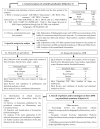Analysis of the Circular Economic Production Models and Their Approach in Agriculture and Agricultural Waste Biomass Management
- PMID: 33419338
- PMCID: PMC7767155
- DOI: 10.3390/ijerph17249549
Analysis of the Circular Economic Production Models and Their Approach in Agriculture and Agricultural Waste Biomass Management
Abstract
As of now, circular economic production models of the circular economy (CEPMs), which include circular economy, bioeconomy, and circular bioeconomy, are among the main tools characterizing development policies in different countries. During the last five years, policies and strategies regarding CEPMs have promoted and contributed to the development of research on this topic. The evolution and most relevant aspects of the three CEPMs previously mentioned have been analyzed from a sample of 2190 scientific publications obtained from the Scopus database. Bibliometric analysis has been used to evaluate the approach of these models in agriculture and to introduce the ways in which they address the management of agricultural waste biomass (AWB). Results show that the circular economy is the most studied and prioritized model in China and most European countries, with the UK leading the way. Germany leads in topics related to the bioeconomy. The management policies and strategies of the circular bioeconomy are key to promoting research focused on AWB valorization since bioenergy and/or biofuel production continue to be a priority.
Keywords: agricultural waste biomass; agriculture; bioeconomy; circular bioeconomy; circular economic production model; circular economy.
Conflict of interest statement
The authors declare no conflict of interest.
Figures











Similar articles
-
Sustainable and circular agro-environmental practices: A review of the management of agricultural waste biomass in Spain and the Czech Republic.Waste Manag Res. 2023 May;41(5):955-969. doi: 10.1177/0734242X221139122. Epub 2022 Dec 14. Waste Manag Res. 2023. PMID: 36519229 Free PMC article. Review.
-
Recovery of agricultural waste biomass: A path for circular bioeconomy.Sci Total Environ. 2023 Apr 20;870:161904. doi: 10.1016/j.scitotenv.2023.161904. Epub 2023 Jan 31. Sci Total Environ. 2023. PMID: 36736404 Review.
-
Shell-based agricultural wastes biomass valorization for biofuel production: a bibliometric analysis into the circular bioeconomy.Environ Sci Pollut Res Int. 2025 Jan;32(3):1095-1119. doi: 10.1007/s11356-024-35766-6. Epub 2024 Dec 30. Environ Sci Pollut Res Int. 2025. PMID: 39739169 Review.
-
An efficient agro-industrial complex in Almería (Spain): Towards an integrated and sustainable bioeconomy model.N Biotechnol. 2018 Jan 25;40(Pt A):103-112. doi: 10.1016/j.nbt.2017.06.009. Epub 2017 Jul 8. N Biotechnol. 2018. PMID: 28698129 Review.
-
Sustainability and circularity in fruit and vegetable production. Perceptions and practices of reduction and valorization of agricultural waste biomass in south-eastern Spain.J Environ Manage. 2022 Aug 15;316:115270. doi: 10.1016/j.jenvman.2022.115270. Epub 2022 May 19. J Environ Manage. 2022. PMID: 35597214
Cited by
-
Management of the Organic Fraction of Municipal Solid Waste in the Context of a Sustainable and Circular Model: Analysis of Trends in Latin America and the Caribbean.Int J Environ Res Public Health. 2022 May 16;19(10):6041. doi: 10.3390/ijerph19106041. Int J Environ Res Public Health. 2022. PMID: 35627577 Free PMC article. Review.
-
The management and prevention of food losses and waste in low- and middle-income countries: A mini-review in the Africa region.Waste Manag Res. 2024 Apr;42(4):287-307. doi: 10.1177/0734242X231184444. Epub 2023 Aug 2. Waste Manag Res. 2024. PMID: 37533307 Free PMC article. Review.
-
Impact of research on maize production challenges in Hungary.Heliyon. 2024 Feb 14;10(6):e26099. doi: 10.1016/j.heliyon.2024.e26099. eCollection 2024 Mar 30. Heliyon. 2024. PMID: 38510009 Free PMC article. Review.
-
From Waste to Resource: Nutritional and Functional Potential of Borlotto Bean Pods (Phaseolus vulgaris L.).Antioxidants (Basel). 2025 May 23;14(6):625. doi: 10.3390/antiox14060625. Antioxidants (Basel). 2025. PMID: 40563260 Free PMC article.
-
Sustainable and circular agro-environmental practices: A review of the management of agricultural waste biomass in Spain and the Czech Republic.Waste Manag Res. 2023 May;41(5):955-969. doi: 10.1177/0734242X221139122. Epub 2022 Dec 14. Waste Manag Res. 2023. PMID: 36519229 Free PMC article. Review.
References
-
- Škrinjarić T. Empirical assessment of the circular economy of selected European countries. J. Clean. Prod. 2020;255:120246. doi: 10.1016/j.jclepro.2020.120246. - DOI
-
- Duque-Acevedo M., Belmonte-Ureña L.J., Toresano-Sánchez F., Camacho-Ferre F. Biodegradable Raffia as a Sustainable and Cost-Effective Alternative to Improve the Management of Agricultural Waste Biomass. Agronomy. 2020;10:1261. doi: 10.3390/agronomy10091261. - DOI
-
- Piotrowski S., Carus M., Essel R. Global Bioeconomy in the Conflict Between Biomass Supply and Demand. Ind. Biotechnol. 2015;11:308–315. doi: 10.1089/ind.2015.29021.stp. - DOI
-
- Stankevičienė J., Nikanorova M., Gentjan Ç. Analysis of Green Economy Dimension in the Context of Circular Economy: The Case of Baltic Sea Region. E M Ekon. A Manag. 2020;23:4–18.
-
- D’Amato D., Droste N., Allen B., Kettunen M., Lähtinen K., Korhonen J., Leskinen P., Matthies B.D., Toppinen A. Green, circular, bio economy: A comparative analysis of sustainability avenues. J. Clean. Prod. 2017;168:716–734. doi: 10.1016/j.jclepro.2017.09.053. - DOI
Publication types
MeSH terms
LinkOut - more resources
Full Text Sources
Research Materials

